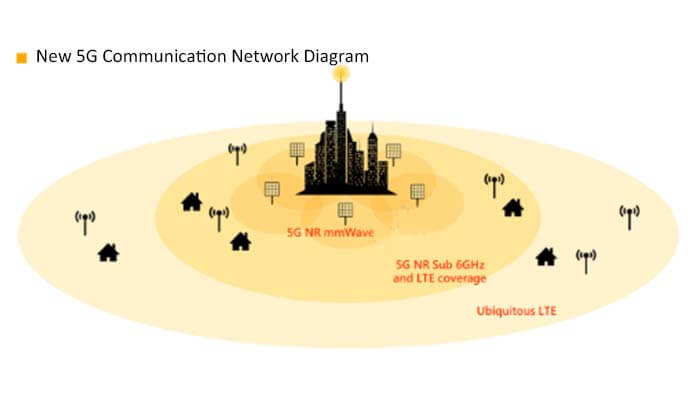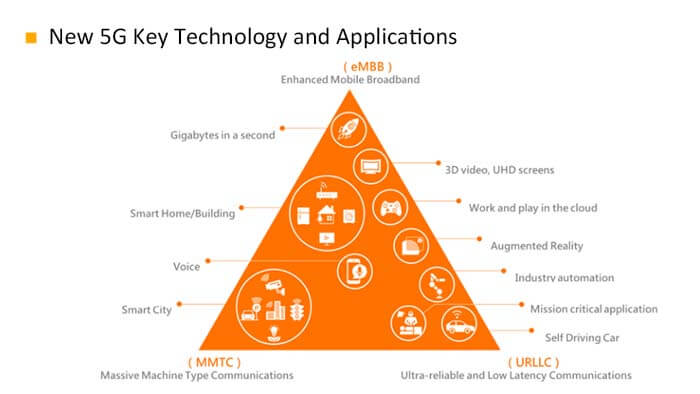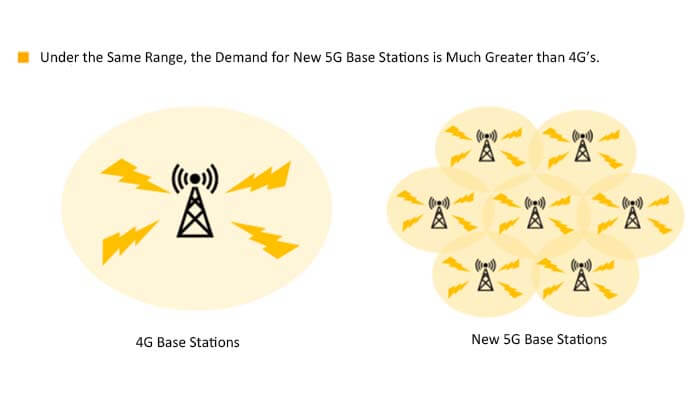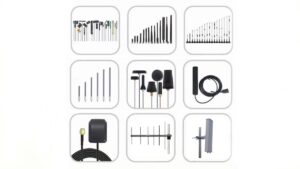Before we talk about what is new 5G technology, let’s start with a basic electromagnetic wave principle, which is: speed of light = wavelength X frequency.

When the speed of light is fixed at 300,000 kilometers per second, the longer the wavelength, the fewer vibrations per second. In other words, the wavelength and frequency of electromagnetic waves are inversely proportional to each other.
Today’s wireless communication (Wireless Communication), that is, the use of electromagnetic waves to carry out a variety of information exchange. Different frequencies of electromagnetic waves determine different characteristics and applications.
In terms of physical properties, the higher the frequency, the shorter the wavelength, the stronger the penetration ability, which is like the hospital X-ray frequency is very high, the wavelength is only 0.01 ~ 10 nanometers, can be used to penetrate part of the body tissue.
However, high-frequency signals are also more directional, and they will want to go straight through obstacles rather than around them (i.e., poor bypass capability), so the energy consumption caused by their penetration of obstacles will also make the transmission distance shorter.
In the current mainstream 4G LTE (Long Term Evolution), the commonly used frequency band is mostly concentrated in the 450MHz to 3,800MHz range. However, since this area is already very congested, we are gradually moving our minds to the millimeter-wave band between 30GHz and 300GHz, where the band resources are relatively abundant (generally speaking, the higher band may have a higher bandwidth, which in turn will drive the transmission speed up).
What is new 5G meaning?
The so-called 5G communication refers to the 5th Generation Mobile Networks, which is a generic term for the next generation of communication networks after the maturity of 4G communication technology, which is nothing more than the pursuit of faster speed and lower latency.
Although the international standard for 5G has not yet been fully determined, it can roughly cover two mainstream frequency bands, one is sub 6GHz (that is, below 6GHz), which is not much different from the 4G LTE band we currently use; the other is above 24GHz, which is the millimeter-wave band that we have heard a lot recently.
In other words, the 5G network actually combines the existing 4G LTE band and is a heterogeneous network (HetNet). Its main focus is on speed through the millimeter wave (mmWave) broadband technology, and the main focus is on low-power, wide coverage capacity of the sub 6GHz narrowband technology, in different environments to provide the most suitable wireless network to meet the short-range and long-range communication requirements at the same time.

For example, when the field requires high bandwidth (eMBB), low latency (URLLC), and other characteristics, it is suitable for the use of the high-frequency millimeter-wave band, such as self-driving, telesurgery, and other applications; when the field requires low power consumption, wide coverage and stable connection characteristics (MMTC), it is more suitable for the sub 6GHz low-frequency band, such as smart city-related applications.

What is new 5G micro base station?
When communication technology is deployed in higher frequency bands, the bypassing ability of electromagnetic waves becomes weaker, and the transmission distance and coverage area will be relatively reduced.
Therefore, unlike 4G, which uses one large base station (Metro Cell) to cover 2 to 40 km in lower frequency bands, multiple micro base stations (Small Cell) must be used to cover the same area in the 5G era.

What is new 5G Massive MIMO?
MIMO refers to Multiple-Input Multiple-Output, that is, through multiple antennas to send, multiple antennas to receive, so that the speed of data transmission becomes faster.
According to the principle of electromagnetic wave, the shorter the wavelength, the smaller the antenna can be made, to the 5G era, as the antenna gradually become millimeter size, we can plug more antennas into the cell phone terminal and micro base station so that the existing MIMO to strengthen the Massive MIMO, so that the speed to a higher level.
What is new 5G beamforming?
The transmission of electromagnetic waves, like a light bulb, is a way to transmit signals in all directions. However, usually, we just pass the signal in a certain direction, and most of the electromagnetic wave energy is wasted. So, is it possible to bind up these scattered electromagnetic waves? The answer is yes, it is called Beamforming.
Beamforming is a technology that transmits and receives signals in a directional manner through an array of antennas. Through the iteration of transmitting or receiving signals in a specific direction, the existing omnidirectional coverage is converted into the precise directional transmission, which not only extends the transmission distance but also significantly reduces signal interference.
What is new 5G’s status?
New 5G is hot, but commercialization is not yet clear.
These are some of the key concepts of 5G, including millimeter-wave, micro base station, Massive MIMO, beamforming, and so on. As these technologies evolve, some applications that have been stuck for a long time, such as VR live streaming, Telematics, drones, telemedicine, smart cities, and other scenarios, will have the opportunity to break through the threshold and emerge from the cocoon.
However, although 5G is currently shouting hot in the market, the actual landing does not seem to be so fast. In addition to the spectrum allocation in each country still pending, telecom operators have to risk the uncertainty to invest more base station construction costs to accelerate the speed of popularity. Overall, the current commercialization of 5G is not yet clear, and related industrial investments still need to be viewed conservatively.
Besides the What is New 5G article, you may also be interested in the below articles.
5G NR Communication Technology And Characteristics
PCB Antenna VS. External Antenna
Ceramic Antenna VS. PCB Antenna, A Comparison Guide
Wifi vs. 5G, is 5G better than Wifi?
Mobile Networks’ Evolution From 1G To 5G



